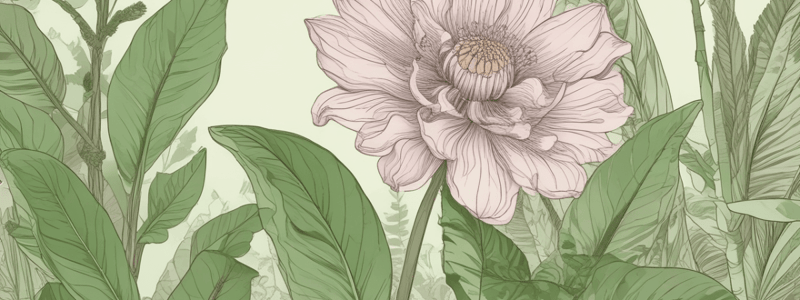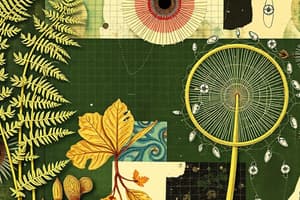Podcast
Questions and Answers
What is the primary purpose of flowers in plants?
What is the primary purpose of flowers in plants?
- To create a fragrance for the surrounding environment
- To provide humans with aesthetic pleasure
- To attract pollinators for reproductive purposes (correct)
- To regulate the water intake of the plant
What is the term for plants that produce flowers and fruits?
What is the term for plants that produce flowers and fruits?
- Petaloforms
- Angiosperms (correct)
- Gymnosperms
- Reproducers
Which part of a flower is responsible for attracting pollinators?
Which part of a flower is responsible for attracting pollinators?
- Stamen
- Petal (correct)
- Stigma
- Sepals
Why do some flowers have specific colors?
Why do some flowers have specific colors?
What is the term for parts of a flower that are not directly involved in the reproductive process?
What is the term for parts of a flower that are not directly involved in the reproductive process?
What is an example of a plant that produces a single flower?
What is an example of a plant that produces a single flower?
What is the relationship between a flower and a plant?
What is the relationship between a flower and a plant?
What is the primary function of sepals in a flower?
What is the primary function of sepals in a flower?
What is the term for the female plant parts collectively?
What is the term for the female plant parts collectively?
What is the purpose of the stigma in a flower?
What is the purpose of the stigma in a flower?
How do plants like pine trees solve the pollen-to-stigma issue?
How do plants like pine trees solve the pollen-to-stigma issue?
What is the purpose of nectar in plants that require pollinators?
What is the purpose of nectar in plants that require pollinators?
What happens to the flower after successful pollination?
What happens to the flower after successful pollination?
What is a characteristic of plants that disperses seeds through animals?
What is a characteristic of plants that disperses seeds through animals?
What is true about the seeds produced by a plant after successful pollination?
What is true about the seeds produced by a plant after successful pollination?
Flashcards are hidden until you start studying
Study Notes
Flower Reproduction
- Flowers are created by plants to assist with their reproductive process, not for human enjoyment.
- Not all plants reproduce using flowers, but many plants, called angiosperms, rely on flowers for reproduction.
- Flowers cannot support themselves without the rest of the plant mass, like the stem, leaves, branches, or roots.
Parts of a Flowering Plant
- Flowers have different parts with distinct names, designated as male, female, or sterile.
- Sterile parts include:
- Petal: brightly colored to attract pollinators, helping in flower fidelity.
- Sepal: small leaves that cover and protect the flower, photosynthetic but not directly involved in reproduction.
- Receptacle: the portion of the stem where it attaches to the flower and sepal, providing stability.
Female and Male Parts
- Pistil is the collective term for female plant parts, consisting of:
- Style: connects other female parts, forming the "neck" shape.
- Stigma: receives pollen, flat and sticky for successful pollen transfer.
- Ovule: unfertilized, incomplete seeds that will develop into offspring.
- Ovary: holds ovules, which will develop into fruit if the plant is a fruiting angiosperm.
- Stamen is the collective term for male parts, consisting of:
- Anthers: produce and hold pollen.
- Filament: holds anthers in place.
How Flowers Reproduce
- Pollen from anthers must reach the stigma, which neither male nor female parts can do alone, similar to humans.
- Flowers solve the pollen-to-stigma issue in different ways, including:
- Wind: used by trees, like pine trees, which excrete huge amounts of pollen.
- Pollinators: plants offer nectar and sweet smells to attract pollinators, like bees, which bring pollen to the stigma.
- After pollination, the female reproductive organs combine ovule and pollen to create a seed, containing a genetically unique individual plant.
- The plant then kills off the flower and focuses on seed dispersal, which can occur through:
- Wind: plants like dandelions forming fluffy, aerodynamic structures called pappus.
- Animals: plants like sweet gum trees growing round, spiky seed pods that latch onto animals.
- Expulsion: rare plants, like the poisonous squirting cucumber, ejecting seeds with force.
Studying That Suits You
Use AI to generate personalized quizzes and flashcards to suit your learning preferences.



